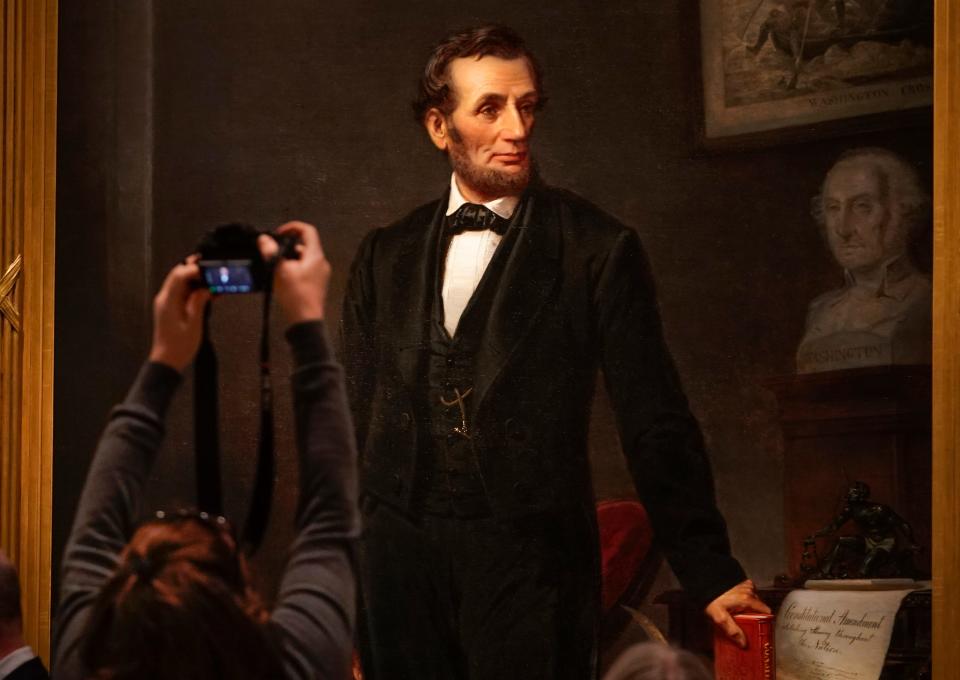Trump, Lincoln ballot comparison meme 'doesn't hold water,' experts say | Fact check
- Oops!Something went wrong.Please try again later.
- Oops!Something went wrong.Please try again later.
- Oops!Something went wrong.Please try again later.
The claim: 10 states removed Abraham Lincoln from the ballot in the 1860 presidential election
A Dec. 21, 2023, Facebook post (direct link, archive link) shows an image of President Abraham Lincoln.
“Removed from the ballot in 10 states in 1860,” reads the post. “How dat work out (sic)?”
It received more than 300 shares in two weeks. Other versions of the claim spread widely on Instagram and Facebook.
Some posts, including a Truth Social post from former President Donald Trump, used the claim to draw a comparison between Lincoln and Trump after Trump was removed from primary ballots in two states.
More from the Fact-Check Team: How we pick and research claims | Email newsletter | Facebook page
Our rating: False
Several experts told USA TODAY Lincoln was not removed from any ballots in the 1860 election. Parties, not states, administered ballots during that election, and since Lincoln's Republican party was virtually nonexistent in the South he wasn't on those ballots in the first place.
Parties in charge of administering ballots in 1860, Republican Party 'essentially didn't exist' in the South
Several experts told USA TODAY the claim is false.
“There were no state-printed ballots in the 19th century from which Lincoln could have been removed,” said University of Virginia American history professor Michael Holt.
Instead, creating and distributing ballots was the responsibility of political parties at that time, Holt explained. Unlike the largely two-party system in place now, four parties vied for power in the 1860 election: the Republican Party, the northern and southern Democratic parties, and the Constitutional Union Party.
The ballots only listed candidates from the respective party for various positions, from local to national offices. Instead of choosing between individuals, voters simply returned the ballot for the party they supported.
Ten of the 11 states that would go on to form the Confederacy did not have ballots with Lincoln’s name on them in the 1860 election, University of Pennsylvania political science professor Rogers Smith said.
That's because the Republican Party “essentially didn’t exist in those 10 states,” according to Rutgers University American studies and history professor Louis Masur. The party had an anti-slavery platform, and efforts to elect Lincoln in those states would have been “futile," he said.
Lincoln still won the electoral college vote despite having less than 40% of the national popular vote, which Smith said is the smallest vote percentage of any president in U.S. history.
It was only in the late 19th century that states took charge of administering ballots and ballots included candidates from different parties.
Fact check: Meme's claim about 4 hangings related to Lincoln's election is false

Holt, who wrote a book on the 1860 election, described the social media posts as a “pretty brazen” attempt to tie Trump to Lincoln in a comparison that “doesn’t hold water.”
His sentiment was echoed by other experts.
“The comparison is a bad one because Lincoln was not deemed ineligible for not meeting the constitutional requirements,” said Kermit Roosevelt, a professor at the University of Pennsylvania's Carey Law School. “Basically, almost no one in those states wanted to vote for him, so the Republican Party didn’t waste the effort distributing ballots.”
Masur also said there is "no relationship" between the two situations and that they are "completely different historical circumstances."
“As a historian, I’m deeply concerned about the ways in which the past is used,” he said. “While there are always applications of the past in the present, it requires understanding the past by its own terms.”
USA TODAY reached out to several users who shared the post for comment but did not immediately receive a response.
Our fact-check sources:
National Museum of American History, accessed Jan. 5, Voting and Electioneering, 1789-1899
Louis Masur, Jan. 4, Phone call with USA TODAY
Kermit Roosevelt, Jan. 3, Email exchange with USA TODAY
Michael Holt, Jan. 3, Phone call with USA TODAY
Rogers Smith, Jan. 3, Email exchange with USA TODAY
National Park Service, Jan. 17, 2021, The Elections of 1860 and 1864
Thank you for supporting our journalism. You can subscribe to our print edition, ad-free app or e-newspaper here.
USA TODAY is a verified signatory of the International Fact-Checking Network, which requires a demonstrated commitment to nonpartisanship, fairness and transparency. Our fact-check work is supported in part by a grant from Meta.
This article originally appeared on USA TODAY: False claim states removed Lincoln from ballot in 1860 | Fact check
